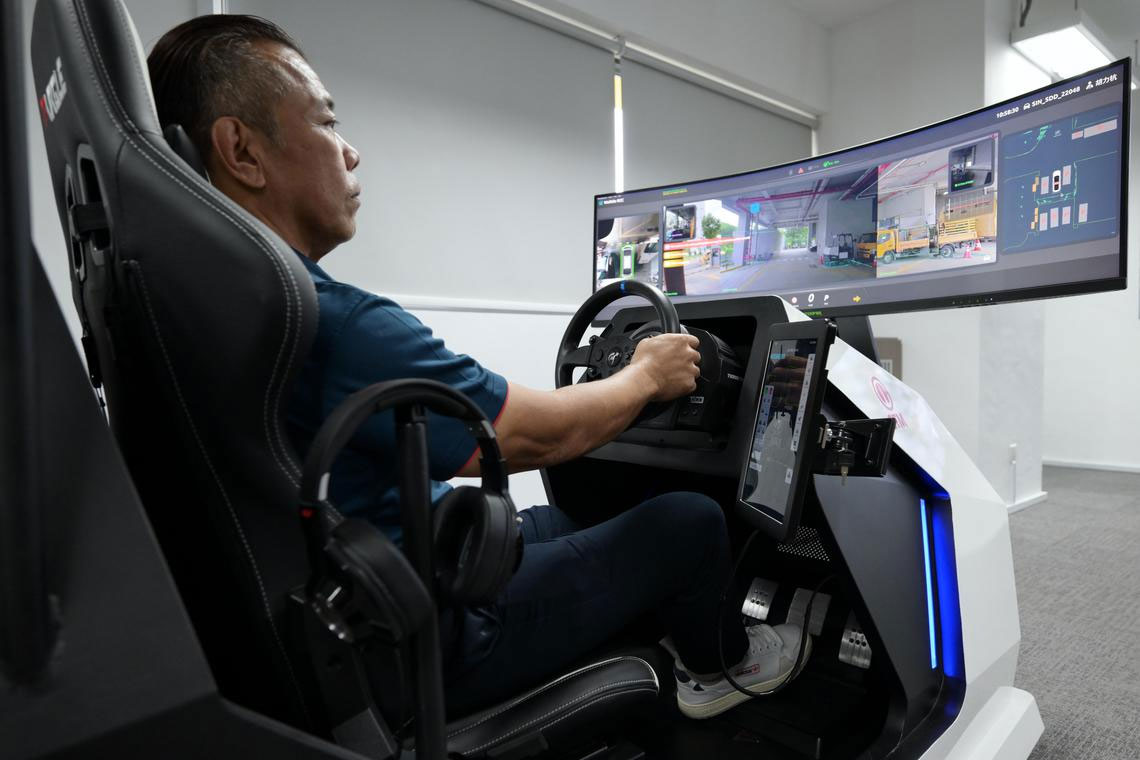The driverless road sweepers can operate round-the-clock while being monitored remotely by an operator, to enhance safety.ST PHOTOS: NG SOR LUAN
SINGAPORE – Environmental services firm Chye Thiam Maintenance aims to deploy two driverless road sweepers in a trial on public roads in the Marina coastal area by the end of 2024.
The road sweepers can operate round the clock while being monitored remotely by an operator, to enhance safety and optimise operational flexibility and efficiency.
During the trial, however, each of the vehicles will also have a driver on board to ensure safety.
The test comes more than three years after similar trials were done in designated small-scale environments in one-north, Nanyang Technological University and CleanTech Park at Jurong Innovation District.
In a Facebook post on June 12, Minister for Transport Chee Hong Tat, who recently visited Chye Thiam Maintenance, said the Land Transport Authority (LTA) was working with the company on the trial.
“If the pilot is successful, the technology solution could help Chye Thiam Maintenance and other cleaning companies to meet their manpower and business needs in a tight labour market,” he added.
Each of the company’s two electric autonomous road sweepers has 12 cameras and five light detection and ranging (Lidar) remote sensing systems that use laser pulses to map the surroundings and navigate.
A road sweeper has a 360-degree view of the road. The Lidars on the front of the vehicle can detect objects ahead up to 1m away, and the vehicle will stop to avoid collision.
In preparation for the deployment, Chye Thiam Maintenance sent two staff members to the Guangzhou headquarters of the road sweepers’ manufacturer, leading Chinese autonomous-driving technology developer WeRide. There, they conducted checks and acceptance tests, and underwent safety and operational training.

Each of the autonomous road sweepers has 12 cameras and five light detection and ranging (Lidar) remote sensing systems that use laser pulses to map the surroundings and navigate. ST PHOTO: NG SOR LUAN
One of the road sweepers is currently undergoing tests conducted by the Centre of Excellence for Testing and Research of Autonomous Vehicles in Nanyang Technological University (Cetran).
This stringent safety assessment, known as the AV Milestone Testing Regime, must be completed before any autonomous vehicle (AV) can be deployed on public roads. The tests were developed by LTA and Cetran, with input from the Traffic Police.
This entails simulation testing, closed-course testing and on-road testing of an autonomous vehicle, which has to pass three milestones to ensure its safety, reliability and compliance with regulatory standards.
As part of their upcoming trial, each of the vehicles has a driver’s seat installed. This is so that the tests can be conducted in the presence of a trained driver who can take immediate control of the vehicle when needed.
An LTA spokesperson said: “During the initial stages of the pilot, each AV must also have a qualified safety operator on board. The AVs can switch to a remote safety operator only when they have proven their capabilities through rigorous testing and assessments.”
Mr Lim Jo Hann, senior vice-president of operations at Chye Thiam Maintenance, told The Straits Times that if the vehicles prove their capabilities during the trial, future models will be manufactured without steering wheels or side mirrors.
Mr Lim Jo Hann, senior vice-president of operations at Chye Thiam Maintenance said that that if the vehicles prove their capabilities during the tests, future models will be manufactured without steering wheels or side mirrors. ST PHOTO: NG SOR LUAN
Chye Thiam Maintenance also has over 20 mechanical road sweepers and more than 200 diesel-powered vehicles, and intends to have a fully electric fleet in the long term.
The company said it aims to redesign the job, and upskill their existing drivers to operate the electric vehicles. It also believes that unlike the traditional job, remote operations might attract more younger employees.
The firm’s longer-term plan is for one remote operator to monitor up to eight road sweepers simultaneously.
The National Environment Agency (NEA) aims to develop capability in adapting autonomous vehicle technology for road sweeping, as part of its efforts to drive industry transformation for the cleaning sector.
NEA said its Autonomous Environmental Service Vehicles (AESV) proof-of-concept trials in 2021 achieved its project objectives and passed preliminary tests by the LTA.
The road sweepers are monitored remotely by an operator, to enhance safety and optimise operational flexibility and efficiency.ST PHOTO: NG SOR LUAN
In the first trial, NEA deployed two AESVs during off-peak hours on public roads in the designated small-scale environments.
These vehicles were developed by two consortia, which were awarded research and development projects by NEA and Ministry of Transport in March 2019 to apply autonomous vehicle technology to commercial road sweepers.
Each of the vehicles had a safety driver on board at all times who was trained to take immediate control of the vehicle when required, and the vehicles were also monitored in real-time by an off-site operator.
“With the learnings from the project, NEA continues to facilitate trials for the industry, such as the autonomous road sweeping trial proposed by Chye Thiam Maintenance along designated public roads.
“We look forward to the future possibility of service providers deploying driverless sweepers for NEA’s Integrated Public Cleaning contracts, subject to them meeting LTA’s and NEA’s expectations,” the agency said.